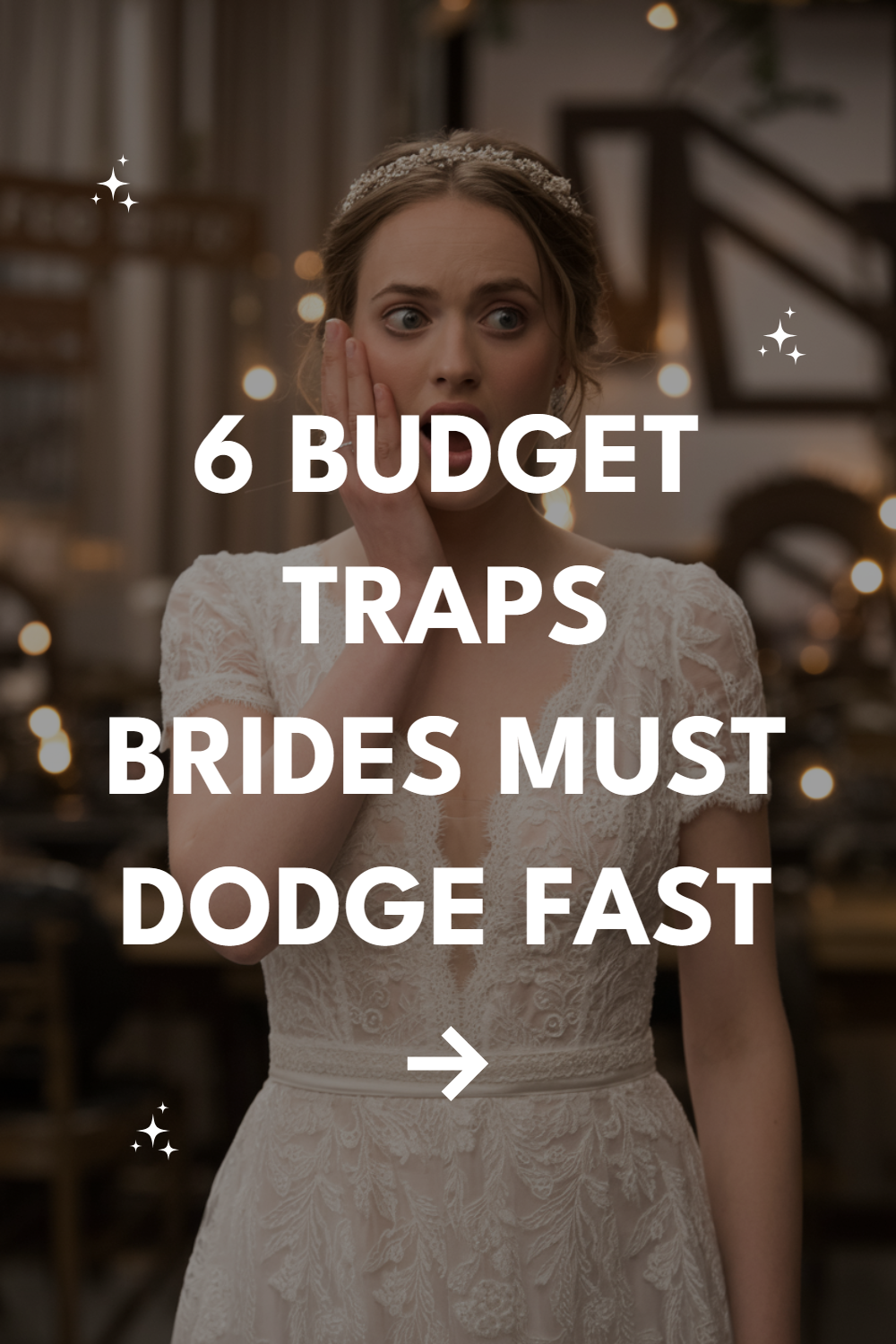Planning a wedding is like navigating a financial minefield while wearing a blindfold and carrying a champagne flute. One wrong step, and your dream day becomes a debt nightmare that haunts you long after the last dance.
Let me share the six most dangerous budget traps that can derail even the most organized bride—and how to sidestep them with your sanity (and savings) intact.
1. The Percentage Trap
Vendors love throwing around percentages like confetti at a ceremony. “Flowers should be 8-10% of your budget,” they’ll say with the confidence of someone who’s never had to choose between centerpieces and groceries.
Here’s the brutal truth: percentages are marketing tools disguised as helpful guidelines. When you’re working with a $15,000 budget, that “standard” 10% for flowers suddenly means $1,500 for arrangements that will wilt in three days.
Meanwhile, a couple with a $50,000 budget gets told they should spend $5,000 on the same basic floral needs.
Your actual flower requirements don’t magically multiply because you have more money. You still need one bridal bouquet, not three. The venue still has the same number of tables, regardless of your budget size.
The Reality Check Method
Start with what you actually need, then price it out. Want centerpieces for eight tables? Get quotes for eight centerpieces, not for “10% of your budget worth” of flowers.
This shifts the conversation from abstract percentages to concrete numbers. Suddenly, you’re comparing $200 centerpieces to $75 ones, not wondering if you’re spending the “right percentage” on decor.
2. The Upgrade Avalanche
Vendors have perfected the art of the innocent upgrade suggestion. It starts small—maybe $200 for premium linens instead of standard ones. Then comes the upgraded lighting package, the enhanced bar service, the “seasonal flower premium.”
Each upgrade seems reasonable in isolation. Premium linens for just $200 more? That’s barely $25 per table. But by the time you’ve said yes to six “small” upgrades, you’ve blown through an extra $1,500 without realizing it.
The psychology here is diabolical. Vendors present upgrades after you’ve already committed to their base package, when you’re emotionally invested and your guard is down.
The Upgrade Audit
Before meeting with any vendor, decide your maximum spend for their service. When they present upgrades, ask for the total cost in writing before making any decisions.
Create a simple rule: any upgrade over $100 requires a 24-hour waiting period. This cooling-off time helps you evaluate whether the enhanced napkin rings are really worth sacrificing part of your honeymoon fund.
3. The Hidden Fee Maze
Wedding contracts are like icebergs—the visible costs are just the tip. Beneath the surface lurk delivery fees, setup charges, service fees, and the dreaded “coordination fee” for services you assumed were included.
Photographers charge travel fees for venues more than 30 minutes away. Caterers add 22% service charges that aren’t tips. Florists tack on delivery and setup fees that somehow cost more than the actual flowers.
These fees aren’t necessarily dishonest, but they’re often buried in fine print or mentioned casually during final planning meetings. By then, changing vendors feels impossible, and you’re trapped into paying whatever they demand.
The Total Cost Reality
Never compare vendor quotes based on their headline prices alone. Create a spreadsheet with columns for base price, all fees, taxes, and tips to see the true total.
Ask every vendor upfront: “What additional fees or charges might apply?” Push for specifics. If they can’t give you a comprehensive breakdown, consider it a red flag.
4. The Emotional Spending Spiral
Wedding planning hits you in the feelings, and feelings make terrible financial advisors. You’ll find yourself spending $300 on a cake knife because it’s “special” or upgrading to premium invitations because “we only get married once.”
The emotional spending trap is particularly vicious because it disguises overspending as love and commitment. Questioning these purchases feels like questioning your devotion to your partner or the importance of your wedding day.
Social media amplifies this trap exponentially. Every Pinterest board and Instagram post shows you something else you “need” to make your wedding perfect.
The Emotional Spending Circuit Breaker
Institute a mandatory waiting period for any purchase over $150 that wasn’t in your original plan. Sleep on it, talk to a trusted friend, or even call your mom.
Create a “wedding wishlist” document where you can dump all those “must-have” ideas. Review it weekly and you’ll be amazed how many “essential” items lose their appeal after a few days.
5. The Vendor Recommendation Trap
Your venue coordinator has the perfect caterer to recommend. Your photographer knows an amazing florist. Your DJ has a great lighting guy. How convenient—and how expensive.
Vendor recommendation networks often involve kickbacks, referral fees, or inflated pricing that gets split between the recommending and recommended vendors. You’re not getting unbiased advice; you’re getting steered toward whoever pays the best commissions.
Even when there’s no financial arrangement, vendors tend to recommend others in their price tier. Your high-end photographer won’t suggest budget-friendly florists because they don’t want their work associated with obviously cheaper elements.
The Independent Research Rule
Always get at least one quote from a vendor you found independently, outside any recommendation network. This gives you a baseline for comparison and leverage in negotiations.
When vendors make recommendations, ask directly: “Do you receive any compensation or referral fees from vendors you recommend?” Their reaction will tell you everything you need to know about their motivations.
6. The Last-Minute Panic Spending
As your wedding date approaches, panic sets in. Suddenly, everything feels inadequate. The flowers aren’t full enough, the lighting isn’t romantic enough, the favors aren’t cute enough.
This panic creates a perfect storm for overspending. You’re running out of time to research alternatives, vendors know you’re desperate, and your emotional state makes rational decision-making nearly impossible.
The last-minute panic trap is where many brides blow their contingency funds on things they’ll barely notice on their wedding day. Emergency flower upgrades, additional lighting rentals, and upgraded linens become expensive band-aids for pre-wedding anxiety.
The Panic Prevention Plan
Lock in your final vendor details at least six weeks before your wedding. After that point, no changes unless there’s a genuine emergency (and hurt feelings about centerpiece height don’t qualify).
Create a “good enough” standard for yourself. Your wedding doesn’t need to be perfect; it needs to be yours. Those slightly wilted petals or dimmer-than-ideal lighting won’t matter when you’re dancing with your new spouse.
The Bottom Line Strategy
Budget traps work because they exploit our emotions, our trust, and our inexperience with wedding planning. Vendors aren’t necessarily villains, but they are running businesses, and their financial interests don’t always align with yours.
The best defense is awareness combined with systems that protect you from your own emotional impulses. Set hard spending limits, build in waiting periods, and never make financial decisions when you’re feeling overwhelmed or pressured.
Your wedding day will be beautiful because you’re marrying someone you love, not because you spent an extra $2,000 on upgrades you won’t remember. Keep that perspective, and you’ll dodge these budget traps while still creating the celebration you actually want.


